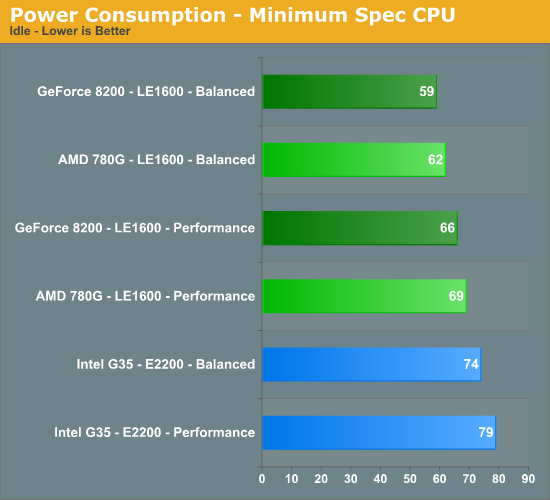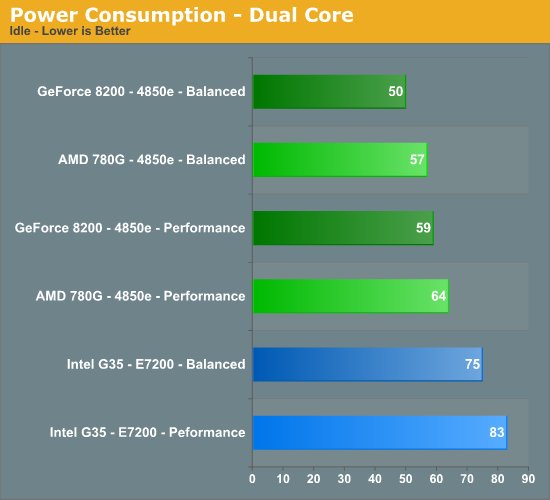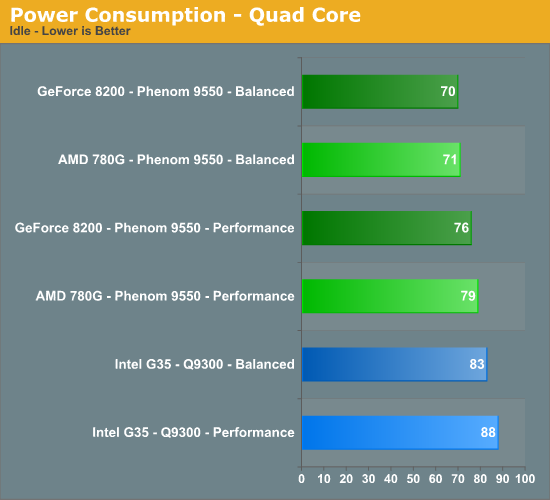IGP Power Consumption - 780G, GF8200, and G35
by Gary Key on April 18, 2008 2:00 AM EST- Posted in
- CPUs
Idle Tests
We enabled the power management capabilities of each chipset in the BIOS and set our voltage selections to auto except for memory. We set memory to 1.90V to ensure stability at our timings. The boards would default to 1.80V or 1.85V, but we found 1.90V necessary for absolute stability in our configurations at the rated 4-4-4-12 timings.
On the two AMD boards, this resulted in almost identical settings with the exception being chipset voltages, although those were within a fraction of each other. Overall, each of the CPUs hovered around 1.250V and all power management options functioned perfectly on these particular board choices. We then set Vista to use either the Performance or Balanced profiles depending on test requirements.
We typically run our machines with the balanced profile. Using the Power Savings setting resulted in a decrease of 1W to 5W depending on the CPU and application tested. At idle, the Balanced and Power Savings profiles both set the minimum value for processor power management to 5%, while the maximum is set to 100% for Balanced and 50% for Power Savings. The Performance setting sets both values to 100% and is the reason for the increases in power requirements even if you have power management turned on in the BIOS.



The
results surprised us - more like floored us. The same company that brings you
global warming friendly chipsets like the 680i/780i has suddenly turned a new
leaf, or at least saved the tree it came from. We see the GeForce 8200 besting
the AMD 780G and Intel G35 platforms in our minimum spec configuration utilizing
the Power Saving profile by 3W and 15W respectively. To be fair to Intel, we
are comparing a single core AMD processor to a dual-core processor. However,
these are the minimum CPUs we would utilize. (4/19/08 Update - Minimum Spec chart is correct now)
Frankly, the AMD LE1600 is just on the verge of not being an acceptable processor during HD playback. The LE1600 was able to pass all of our tests, but the menu operation was slow when choosing our movie options and CPU utilization did hit the upper 90% range on some of the more demanding titles even with the 780G or GF8200 providing hardware offload capabilities.
The pattern changes slightly with the dual-core setup having a 7W and 25W advantage for the GF8200. Our quad-core results are almost even with the GeForce 8200 board from Biostar having only a 1W difference compared to the Gigabyte 780G setup. The GeForce 8200/Phenom 9550 combo comes in with a 13W advantage over the Q9300 on the ASUS G35 board.










44 Comments
View All Comments
Johnniewalker - Friday, April 18, 2008 - link
I would also like to see what would happen if you swapped out the PSU with a lower power one such as the Seasonic S12 II 380w or 430w.If we are maxing out at 115w on the Intel G35 Quad Core, it would seem that either of those PSU's would provide more than adequate power. Would they draw less than a larger PSU or not. If they do, is the difference worth limiting yourself to a small PSU? I am not sure how limited I mean as the 430 PSU is both crossfire and sli certified.
kb9fcc - Friday, April 18, 2008 - link
I found it so surprising that the single core CPU LE-1600 should be beat out by it's multi-core sibling the 4850E, that I had to look for an explanation.The first thing I noticed, is I could find no data on the 4850E, it didn't even appear at AMD's site. However, I found data for the 4050E and 4450E at Newegg, so I'll just have to assume that the 4850E is just a faster clock speed (in future articles, could you please have more details on the processors used, especially new/unknown/unavailable units?).
They're all rated at 45w and have the same amount of cache, so that leaves that fact that the LE-1600 is built on 90nm vs. 65nm tech of the 4850E to be the only cause of this effect, though one wonders if there were other enhancements in the stepping that could be responsible too. That begs the question, what if a single core based on 65nm were used? The only I can find are the LE-1200 series, which are Semperons by definition and have less cache.
Further, regarding the results that the 8200 board used less than the 780G, I question based on not knowing anything about the Biostar TF8200 A2+ at all. Does it have exactly the same features as the Gigabyte MA78GM-S2H? I.e., are there any other chipset differences on the boards that could account for the power draw? (1394, sound, raid, etc.) Also, do other 8200 based boards return the same results? As for that thought, how do other 780G boards fare (Asus, Biostar, ECS)? Why not put the TF8200 up against its Biostar 780G sibling the TFORCE TA780G M2+? I think calling the 8200 the winner is premature without any other data points.
Final thought. Just how green can you go? By selecting the right CPU, memory, HD, PS, fans, cases, etc., what can we learn from this test that we can use to select greener components next time? Do really need a 2.5GHz 4850E, or will a 2.3GHz 4450E do as well and draw less? For that matter, just how does an LE-1250 fare? Sure it may not work out in a HTPC, but what can it do? Do we really need two optical drives, especially if the LG unit does it all? Can we use a lower wattage, high efficiency PS to good effect? Are there memory modules that are stable at 1.8v that draw fewer watts? Can only 2GB be used? What about 2x2GB instead of 4x1GB? etc., etc. etc.
cghebert - Friday, April 18, 2008 - link
Regarding the differences between 8200 and 780g. The MAJOR one, for me anyway, is that the 8200 boards will be ably to output 8 channel uncompressed sound (for HD DVD and Blu Ray) from their HDMI ports. 780g (and every other HDMI motherboard, with the exception of the Asus Intel G35 board) only puts out the equivalent of 2 channel uncompressed audio (or 5.1 compressed, i.e. AC3).This is why I (and many others over at AVS forums) have been eagerly anticipating the 8200 boards.
To me that is the most distinctive issue between these two chipsets. Beyond that, most of it just comes down to ATI vs. Nvidia video quality/driver issues.
Much more info on this discussion here:
http://www.avsforum.com/avs-vb/showthread.php?t=99...">http://www.avsforum.com/avs-vb/showthread.php?t=99...
royalcrown - Sunday, April 20, 2008 - link
You may want to wait and see about the quality issues as certain families of Nvidia chipsets were notorious for data corruption and it appears that that may be an issue with the 700 series according to a blog on here.Read all of the postcards from the edge, and maybe wait for some reviews to be safe ;)
lightzout - Saturday, April 19, 2008 - link
Wow, the HDMI output and the potential to run a cooler, quieter box may mean I will finally be able to get my HTPC box into the living room and hooked up to the HDTV. I am as green as anyone can be without going off-grid with solar but the minimal differences in wattage here aren't the only upside. I want to have a silent pc that works great. It nice to see companies headed towards efficiency but improving other areas of the home are more likely to offer a substantial reduction of power usage overall.I want a low power, stable platform for MCE2005 that will fit into my Dvine box. Right now I use an underclocked nforce2 with a geforce 6200 which barely manages the workload. Its too noisy and consumes too much power to justify running 24/7 so I miss recording some shows. I think I may have finally waited long enough to upgrade.
This was a great article and I hope Anandtech continues to follow other efforts to produce greener, quieter components for the "cooler" under-clocking crowd.
DanDeighan - Friday, April 18, 2008 - link
These CPU's ARE available. Have been since the 15th. Mostly smaller vendors (see Froogle), but also available through buy.com or Amazon.com. Newegg is trailing on this one, not available there yet.Locutus465 - Friday, April 18, 2008 - link
Seems like availability for AMD products is a little uneven these days... For instance I was going to just purchase my entire "new" rig from ZipZoomFly until I realized (thankfully I did some digging before ordering) that they don't offer any B3 Phenoms. Ended up getting the Phenom 9850be from newegg. Not sure why zipzoomfly is just sitting around with out any B3 parts.FireTech - Friday, April 18, 2008 - link
bingbong may be in Australia where AMD Australia is reported (on various user forums) as stating low sales volumes of previous 45w CPUs here do not justify importing the new 4850e etc CPUs here.Not good news if it turns out to be true...
bingbong - Friday, April 18, 2008 - link
Nice to see some good low power options with a decent intergrated graphics set. Awaiting the shoot out to see 780G or 8200 will be the best bet.I am kind of pissed that the AMD 4850e chip cannot be found.
What's the point of reviewing this from February when it seems like AMD are not going to be making the CPU available.
Come on AMD!!!
Or don't you want our money!
Martimus - Friday, April 18, 2008 - link
http://www.buy.com/prod/amd-athlon-64-x2-dual-core...">http://www.buy.com/prod/amd-athlon-64-x...mhz-ht-1...Plus many other places, but not on newegg yet.